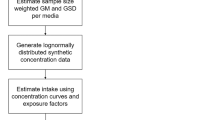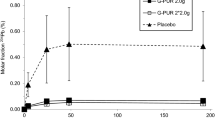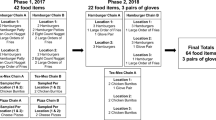Abstract
The U.S. Food and Drug Administration’s (FDA) Total Diet Study (TDS) monitors the US food supply for pesticide residues, industrial chemicals, radionuclides, nutrients, and toxic elements. Perchlorate and iodine intakes based on concentrations in TDS samples collected between 2008 and 2012 were estimated in order to update an earlier TDS dietary assessment. Perchlorate is used as an oxidizing agent in rocket and missile fuel, is formed naturally in the atmosphere, and occurs naturally in some soils. Because of perchlorate’s presence in soil, and in irrigation, processing, and source water, it is widely found in food. Iodine was included in the study because perchlorate at high doses interferes with iodide uptake in the thyroid. Iodine (the elemental form of iodide) is essential for growth and development, and metabolism. This study uses a novel statistical method based on a clustered zero-inflated lognormal distribution model to estimate mean and 95th percentile confidence interval concentrations for perchlorate and iodine in US foods. These estimates were used to estimate mean perchlorate and iodine exposures for the total US population and for 14 age/sex groups in the US population. Estimated mean perchlorate intake for the total US population was 0.13 μg/kg bw/day, with mean intakes for the 14 age/sex groups between 0.09 and 0.43 μg/kg bw/day. The estimated mean intakes of perchlorate for all age/sex groups were below EPA’s reference dose (RfD) of 0.7 μg/kg bw/day. The estimated mean iodine intake for the total US population was 216.4 μg/person/day, with mean intakes ranging from 140.9 to 296.3 μg/person/day for the 14 age/sex groups, with all age/sex groups exceeding their respective estimated average requirements (EARs).
This is a preview of subscription content, access via your institution
Access options
Subscribe to this journal
Receive 6 print issues and online access
$259.00 per year
only $43.17 per issue
Buy this article
- Purchase on Springer Link
- Instant access to full article PDF
Prices may be subject to local taxes which are calculated during checkout
Similar content being viewed by others
References
Egan SK, Bolger PM, Carrington CD . Update of US FDA’s Total Diet Study food list and diets. J Expo Sci Environ Epidemiol 2007; 17: 573–582.
Murray CW, Egan SK, Kim H, Beru N, Bolger PM . US Food and Drug Administration’s Total Diet Study: Dietary intake of perchlorate and iodine. J Expo Sci Environ Epidemiol 2008; 18: 571–580.
U.S. Environmental Protection Agency Integrated Risk Information System. Perchlorate and Perchlorate Salts. 2014: Washington, DC, Available at http://www.epa.gov/iris/subst/1007.htm. Accessed March 4, 2016.
U.S. Environmental Protection Agency. Request for nominations for peer reviewers for EPA’s Biologically Based Dose-Response (BBDR) Model for perchlorate in drinking water. 81 Federal Register 2016. 10617-10618.
U.S. Environmental Protection Agency. Request for public comments to be sent to Versar, Inc., on an interim list of perchlorate in drinking water expert peer reviewers and draft peer review charge questions. 81 Federal Register 2016. 67347-67348.
U.S. Environmental Protection Agency. Request for public comments to be sent to EPA on peer review materials to inform the Safe Drinking Water Act decision making on perchlorate. 81 Federal Register 2016. 67350-67351.
Dasgupta PK, Dyke JV, Kirk AB, Jackson WA . Perchlorate in the United States. Analysis of Relative Source Contributions to the Food Chain. Environ Sci Technol 2006; 40: 6608–6614.
Dasgupta PK, Martinelango PK, Jackson WA, Anderson TA, Tian K, Tock RW et al. The origin of naturally occurring perchlorate: the role of atmospheric processes. Environ Sci Technol 2005; 39: 1569–75.
Huber DR, Blount BC, Mage DT, Letkiewicz FJ, Kumar A, Allen RH . Estimate perchlorate exposure from food and tap water based on US biomonitoring and occurrence data. J Expo Sci Environ Epidemiol 2011; 21: 395–407.
Greer MA, Goodman G, Pleus RC, Greer SE . Health effects assessment for environmental perchlorate contamination: the dose response for inhibition of thyroidal radioiodide uptake in humans. Environ Health Perspect 2002; 110: 927–937.
Pearce EN, Braverman LE . Environmental pollutants and the thyroid. Best Pract Res Clin Endocrinol Metab 2009; 23: 801–813.
Schier JG, Wolkin AF, Valentin-Blasini L, Belson MG, Kieszak SM, Rubin CS et al. Perchlorate exposure from infant formula and comparisons with the perchlorate reference dose. J Expo Sci Environ Epidemiol 2010; 20: 281–287.
Hartoft-Nielsen M-L, Boas M, Bliddal S, Rasmussen AK, Main K, Feldt-Rasmussen U . Do thyroid disrupting chemicals influence foetal development during pregnancy? J Thyroid Res 2011; 2011: 342189.
National Research Council Health Implications of Perchlorate Ingestion. National Academies Press: Washington, DC. 2005.
U.S. Food and Drug Administration 2004–2005 Exploratory survey data on perchlorate in food. 2007: College Park, Available at: http://www.fda.gov/Food/FoodborneIllnessContaminants/ChemicalContaminants/ucm077685.htm. Accessed March 4, 2016.
Pearce EN, Leung AM, Blount BC, Bazrafshan HR, He X, Pino S et al. Breast milk iodine and perchlorate concentrations in lactating Boston-area women. J Clin Endocrinol Metab 2007; 92: 1673–1677.
Valentin-Blasini L, Blount BC, Otero-Santos S, Cao Y, Bernbaum JC, Rogan WJ . Perchlorate exposure and dose estimates in infants. Environ Sci Technol 2011; 45: 4127–4132.
Wang Z, Lau BP-Y, Tague B, Sparling M, Forsyth D . Determination of perchlorate in infant formula by iosotope dilution ion chromatography/tandem mass spectrometry. Food Addit Contam Part A Chem Anal Control Expo Risk Assess 2011; 28: 799–806.
Wang Z, Forsyth D, Lau BP-Y, Pelletier L, Bronson R, Gaertner D . Estimated dietary exposure of Canadians to perchlorate through the consumption of fruits and vegetables available in Ottawa markets. J Agric Food Chem 2009; 57: 9250–9255.
Jackson WA, Joseph P, Laxman P, Tan K, Smith PN, Yu L et al. Perchlorate accumulation in forage and edible vegetation. J Agric Food Chem 2005; 53: 369–373.
Sanchez CA, Crump KS, Krieger RI, Khandaker NR, Gibbs JP . Perchlorate and nitrate in leafy vegetables of North America. Environ Sci Technol 2005; 39: 9391–9397.
Sanchez CA, Krieger RI, Moore RC, Holts KC, Neidel LL . Accumulation and perchlorate exposure potential of lettuce produced in the lower Colorado river region. J Agric Food Chem 2005; 53: 5479–5486.
Blount BC, Valentin-Blasini L, Osterloh JD, Mauldin JP, Pirkle JL . Perchlorate exposure of the US population, 2001-2002. J Expo Sci Environ Epidemiol 2006; 17: 400–407.
Lau FK, deCastro R, Mills-Herring L, Tao L, Valentin-Blasini L, Alwis KU et al. Urinary perchlorate as a measure of dietary and drinking water exposure in a representative sample of the United States population 2001–2008. J Expo Sci Environ Epidemiol 2013; 23: 207–214.
Mendez W, Dederick E, Cohen J . Drinking water contribution to aggregate perchlorate intake of reproductive-age women in the United States estimated by dietary intake simulation and analysis of urinary excretion data. J Expo Sci Environ Epidemiol 2010; 20: 288–297.
Blount BC, Alwis KU, Jain RB, Solomon BL, Morrow JC, Jackson WA . Perchlorate, nitrate, and iodide intake through tap water. Environ Sci Technol 2010; 44: 9564–9570.
U.S. Food and Drug Administation Total Diet Study—Study Design 2015. Available at: http://www.fda.gov/food/foodscienceresearch/totaldietstudy/ucm184232.htm#. Accessed March 4, 2016.
Krynitsky AJ, Niemann RA, Williams AD, Hopper ML . Streamlined sample preparation procedure for determination of perchlorate anion in foods by ion chromatography-tandem mass spectrometry. Anal Chim Acta 2006; 567: 94–99.
Fischer PWF, L’Abbe MR, Giroux A . Colorimetric determination of total iodine in foods by iodide-catalyzed reduction of Ce. J Assoc Off Anal Chem 1986; 69: 687–689.
European Food Safety Authority. Management of left-censored data in dietary exposure assessment of chemical substances. EFSA J 2010; 8: 1–96.
World Health Organization GEMS/Food-EURO second workshop on reliable evaluation of low-level contamination of food. Kulmbach, Germany 1995.
Aerts M, Bakker MI, Ferrari P, Fuerst P, Tressou J, Verger P, J-P. Reporting and modeling of results below the limit of detection. In: Moy GG, Vannoort RW (eds). Total Diet Studies. Springer: New York. 2013.
El-Shaarawi AH, Esterby SR . Replacement of censored observations by a constant: an evaluation. Wat Res 1992; 26: 835–844.
Moulton LH, Halsey NA . A mixture model with detection limits for regression analyses of antibody response to vaccine. Biometrics 1995; 51: 1570–1578.
Taylor DJ, Kupper LL, Rappapport SM, Lyles RH . A mixutre model for occupational exposure mean testing with a limit of detection. Biometrics 2001; 57: 681–688.
Chu H, Kensler TW, Munnoz A . Assessing the effect of interventions in the context of mixture distributions with detection limits. Stat Med 2005; 24: 2053–2067.
James W, Stein C . Estimation with quadratic loss. Proc Berkeley Symp Math Stat Prob 1961; 1: 361–379.
Centers for Disease Control and Prevention National Health and Nutrition Examination Survey, 2007-2008, 2009-2010, 2011-2012, and 2014. U.S. Department of Health and Human Services: Hyattsville, MD. 2014. Available at http://www.cdc.gov/nchs/nhanes.htm. Accessed March 4, 2016.
U.S. Department of Agriculture, U.S. Department of Health and Human Services What we eat in America, 2007–2008, 2009–2010, and 2011–2012, 2014. Agricultural Research Service: Beltsville, MD. 2014. Available at http://www.cdc.gov/nchs/nhanes/wweia.htm. Accessed March 4, 2016.
Smith PN. The Ecotoxicology of Perchlorate in the Environment. In: Gu B, Logan B, Coates J (eds). Perchlorate: Environmental Occurrence, Interactions and Treatment. Springer: New York, NY. 2006, pp 153–157.
Pouillot R, Spungen JH, Abt E, Van Doren JM, Gamalo-Siebers M . Estimation of food analyte concentrations in the presence of non-detect data using a dirichlet process. Risk Anal (submitted).
National Research Council Dietary Reference Intakes for Vitamin A, Vitamin K, Arsenic, Boron, Chromium, Copper, Iodine, Iron, Manganese, Molybdenum, Nickel, Silicon, Vanadium, and Zinc. National Academies Press: Washington, DC. 2000.
Billingsley P . Probability and Measure. John Wiley & Sons: New York 2008.
Juan WY, Trumbo PR, Spungen JH, Dwyer JT, Carriquiry AL, Zimmerman TP et al. Comparison of two methods for estimating the prevalence of inadequate and excessive iodine intakes. Am J Clin Nutr 2016; 104: 888S–897S.
Pehrsson PR, Patterson KY, Spungen JH, Wirtz MS, Andrews KW, Dwyer JT et al. Iodine in food and dietary supplement composition databases. Am J Clin Nutr 2016; 104: 1S–9S.
Acknowledgements
The Total Diet Study is a collaborative effort of FDA’s Center for Food Safety and Applied Nutrition and FDA’s district offices and laboratories. This study used the high-performance computational capabilities of the Scientific Computing Laboratory at the Food and Drug Administration, Center for Devices and Radiological Health.
Author information
Authors and Affiliations
Corresponding author
Ethics declarations
Competing interests
The authors declare no conflict of interest.
Additional information
Supplementary Information accompanies the paper on the Journal of Exposure Science and Environmental Epidemiology website
Rights and permissions
About this article
Cite this article
Abt, E., Spungen, J., Pouillot, R. et al. Update on dietary intake of perchlorate and iodine from U.S. food and drug administration’s total diet study: 2008–2012. J Expo Sci Environ Epidemiol 28, 21–30 (2018). https://doi.org/10.1038/jes.2016.78
Received:
Accepted:
Published:
Issue Date:
DOI: https://doi.org/10.1038/jes.2016.78
Keywords
This article is cited by
-
Iodine status and associated dietary factors among preschool children in Shanghai
Environmental Science and Pollution Research (2023)
-
Removal of perchlorate by a lab-scale constructed wetland using achira (Canna indica L.)
Wetlands Ecology and Management (2022)
-
Factors Associated with Thyroid Disorders and Iodine Adequacy in Pregnant Saudi Women
Biological Trace Element Research (2021)
-
Comparison of ICP-MS and Spectrophotometry Methods for the Analysis of Iodine in 2013 US FDA Total Diet Study Samples
Food Analytical Methods (2018)



